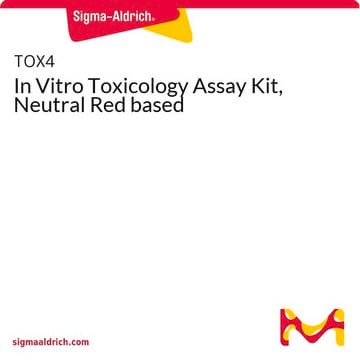1.01369
Neutral red (C.I. 50040)
pH indicator and for microbiology
Synonim(y):
Neutral red (C.I. 50040)
About This Item
Polecane produkty
product name
Neutral red (C.I. 50040), indicator and for microbiology
Poziom jakości
Postać
solid
skład
dye content, ≥75% spectrophotometric assay
strata
≤18% loss on drying, 110°C
pH
3.1 (20 °C, 10 g/L in H2O)
rozpuszczalność
50 g/L
gęstość nasypowa
350‑500 kg/m3
Amax
452-455 nm (buffer pH 8.0)
514-519 nm (buffer pH 6.8)
λmaks.
540-543 nm at 50% in ethanol
temp. przechowywania
2-30°C
InChI
1S/C15H16N4.ClH/c1-9-6-13-15(8-11(9)16)18-14-7-10(19(2)3)4-5-12(14)17-13;/h4-8H,16H2,1-3H3;1H
Klucz InChI
PGSADBUBUOPOJS-UHFFFAOYSA-N
Powiązane kategorie
Zastosowanie
- Smartphone-based sensing and in vivo and in vitro imaging of Mn(VII) based on nitrogen-doped red fluorescent carbon dots.: Li et al. present a novel smartphone-based sensor system utilizing nitrogen-doped red fluorescent carbon dots for detecting Mn(VII) ions. The study leverages the red fluorescence properties of these carbon dots for in vivo and in vitro imaging, enhancing detection accuracy and application in environmental monitoring and biological imaging (Li et al., 2024).
- A "2-in-1" Bioanalytical System Based on Nanocomposite Conductive Polymers for Early Detection of Surface Water Pollution.: Kharkova et al. develop a bioanalytical system integrating nanocomposite conductive polymers to detect surface water pollution. Neutral red is used as an indicator for the electrochemical detection of pollutants, demonstrating the system′s potential for early and accurate environmental monitoring (Kharkova et al., 2024).
- Programable sewage-cleaning technology: Regenerating chitosan biofilms with anti-bacterial capacity via self-purification of water pollutants.: Wu et al. explore a programmable sewage-cleaning technology that regenerates chitosan biofilms with antibacterial properties. Neutral red plays a critical role in evaluating the biofilms′ effectiveness in self-purification processes, offering insights into sustainable wastewater management (Wu et al., 2024).
- Characteristics and adsorption behavior of typical microplastics in long-term accelerated weathering simulation.: Yu et al. examine the characteristics and adsorption behavior of microplastics under long-term weathering. Neutral red staining is employed to study the surface interactions and degradation patterns of microplastics, providing valuable data for environmental impact assessments (Yu et al., 2024).
Komentarz do analizy
Identity (UV/VIS-Spectrum): passes test
Transition range: pH 6.8 - pH 8.0 Violet red - orange yellow
Absorption maximum λmax. (ethanol 50 %): 540 - 543 nm
Absorption maximum λ 1 (buffer pH 6.8): 514 - 519 nm
Absorption maximum λ 2 (buffer pH 8.0): 452 - 455 nm
Spec. Absorptivity A 1%/1cm (λmax; 0.005 g/l; ethanol 50 %): 1180 - 1610
Spec. Absorptivity A 1%/1cm (λ1max; 0.015 g/l; buffer pH 6.8; calc. on dried substances): 425 - 575
Spec. Absorptivity A 1%/1cm (λ2max; 0.015 g/l; buffer pH 8.0; calc. on dried substances): 395 - 535
TLC-Test: passes test
Loss on drying (110 °C): ≤ 18 %
Suitability for microbiology: passes test
Kod klasy składowania
11 - Combustible Solids
Klasa zagrożenia wodnego (WGK)
WGK 3
Temperatura zapłonu (°F)
Not applicable
Temperatura zapłonu (°C)
Not applicable
Certyfikaty analizy (CoA)
Poszukaj Certyfikaty analizy (CoA), wpisując numer partii/serii produktów. Numery serii i partii można znaleźć na etykiecie produktu po słowach „seria” lub „partia”.
Masz już ten produkt?
Dokumenty związane z niedawno zakupionymi produktami zostały zamieszczone w Bibliotece dokumentów.
Nasz zespół naukowców ma doświadczenie we wszystkich obszarach badań, w tym w naukach przyrodniczych, materiałoznawstwie, syntezie chemicznej, chromatografii, analityce i wielu innych dziedzinach.
Skontaktuj się z zespołem ds. pomocy technicznej


